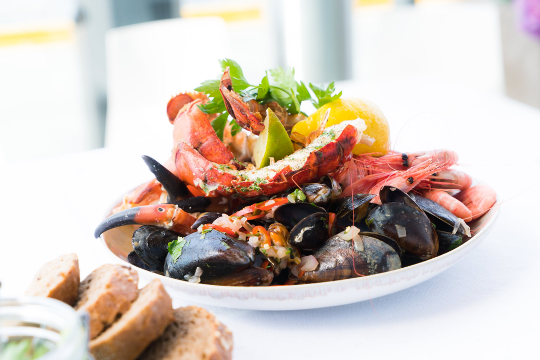From the 13th to the 15th of March 2022, fish and seafood suppliers and buyers from across the globe gathered for the highly anticipated Seafood Expo North America. Taking place at the Boston Convention and Exhibition Centre, this annual event marks the largest trade show for the industry globally, featuring over 830 exhibiting companies from 50 countries!
Of particular interest, the 2022 expo saw the Australian Trade and Investment Commission participate for the first time, highlighting the variety and value of Australian seafood, including abalone and rock lobster, to the rest of the world. With that said, let’s take a closer look at the opportunities for Australian fish and seafood exporters in the USA!
The USA at a Glance
With a GDP of US$20.93 trillion, the USA is an economic powerhouse, cementing its place as the largest economy in the world. Breaking down GDP per capita, this figure is also strong at US$63,051. And, with a total population of over 328 million, the US consumer base is over twelve times that of Australia, creating significant opportunities for exporters seeking to expand their market footprint.
Trade Opening Up Once Again
After the Trump administration’s abandonment of trade-supporting principles, the Biden administration is reversing these actions, enabling the US to fulfil its obligations under 40 bilateral investment agreements. This is good news for Australian and global exporters alike, breaking down the barriers to trade! Regarding Australia specifically, the Australia-United States Free Trade Agreement, remains in place to remove tariffs from 96.1% of Australian exports. The two nations also maintain strong trading relationships, with two-way trade worth $80.8 billion and strong investment ties.
The American Consumer
Sporting middle-class status and a high purchasing power, the US population is filled with keen consumers. Upper-class consumers exercise a significant share of purchases, with OECD forecasts painting this group as the world’s largest market segment until 2030. That being said, a high proportion of weekly spending is generally allocated to lower-priced products, a trend exacerbated by the pandemic. Thus, seeking cheap products is of prime value to the American consumer, and so are products that are widely available and those that can be conveniently purchased.
The American consumer is very particular about the things they buy, frequently comparing prices, reading online reviews and seeking promotions as part of their pre-purchase behaviour. They’re also experimenting with new behaviours, with a recent McKinsey report indicating 75% of shoppers have adapted their purchasing habits since the onset of the pandemic, while 36% reported having tried a new brand, generally leading to brand loyalty. Plus, American consumers are generally keener than their global counterparts when it comes to buying local brands and products.
Expanding Seafood Categories
Despite the global disruptions to supply chains and fluctuating sales levels across the globe, COVID-19 had a rather positive impact on the USA’s fish and seafood sector. Pre-pandemic, consumers veered away from purchasing fish and seafood from retail operators due to their lack of confidence in cooking such items.
But this all changed in 2020, as consumers experienced renewed faith in their cooking skills to widen their palates. Consequently, in 2021, retail sales across all seafood categories were generally strong. This trend was further supported by perceptions of seafood products as healthy sources of protein, especially when flexitarianism and reduced meat consumption are on the rise, and consumer health-consciousness continues to increase, a trend largely driven by the COVID-19 pandemic.
Shellfish
Crustaceans, including crab and lobster, performed exceptionally well in 2021, accounting for over 30% of overall industry revenue. This was largely a result of closures across the foodservice sector, leading consumers to attempt to reproduce excellent meals from the comfort of their own homes. Plus, with foodservice closed, consumers had more cash to spend on more luxury seafood products at the grocery store. Shrimp is generally the most popular shellfish species as it lends itself to a variety of forms of preparation and contains low levels of mercury. This is followed by clams, oysters, crab and lobster.
Finfish
Fresh finfish sales are predicted to account for the majority of fish and seafood sales across the 2021/22 period. In particular, salmon is the most popular species among consumers, due to its richness in flavour and high nutritional value. Other popular finish categories include tilapia, pollock, cod, tuna and catfish, which are generally sold at fish markets.
Growth in Frozen. Ambient and Dried Seafoods
In a highly urbanised country where lifestyles are only set to become busier, it’s no surprise that frozen fish and seafood is the largest seafood category, with a value that’s expected to reach US$3.80 billion by 2025. In a similar vein, ambient products are, and set to remain, the second largest sub-category, with a value of US$3.30 billion forecast by 2025. Looking to 2025, ambient seafood joins chilled raw packaged seafood (whole cuts) and dried seafood as the strongest growth categories, experiencing growth rates above 1.53% over the forecast period.
Wrap Up
So, despite a turbulent past few years for exporters around the world, the US market is one to watch for Australian exporters. With the Boston Seafood Expo North America and renewed consumer confidence in preparing fish and seafood products, interest and activity in the US fish and seafood industry has been reignited, presenting new export possibilities. If this article has sparked your interest, be sure to connect with the Export Connect Team to learn more about why the US market might be right for you!
We hope you’ve found these insights on the USA market helpful. As always, if you’ve got any questions or want to discuss export opportunities for your company, feel free to drop us a line at Export Connect – we’d love to hear from you.




